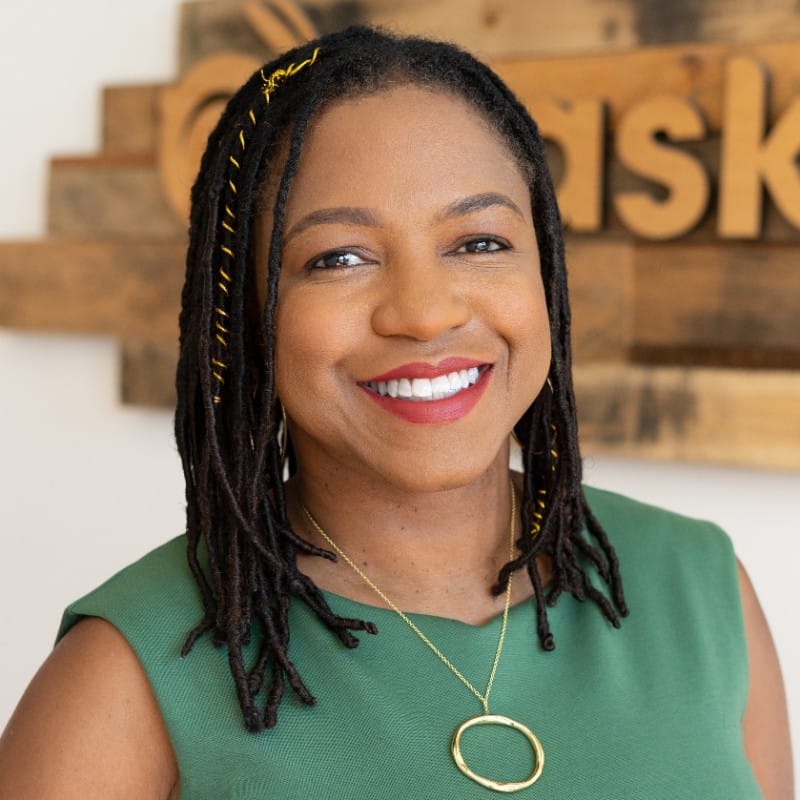Great meetings don’t just happen, they’re meticulously crafted. At its best, an executive meeting strengthens the bonds of your leadership team, surfaces mission-critical problems facing the business, and carves out plans for the future. But as you wade into the executive meeting waters, there are waves that can toss you around. With a limited window of time to cover pressing topics from every corner of the business, the agenda is jam-packed. When wrestling with thorny challenges, heated debates can quickly derail the conversation without a resolution. Annual plans are crafted with care, but without rigorous focus, the business can lose steam.
The executive team’s time is worth a lot, so it’s a shame to waste it. Charting a less choppy course requires careful planning, with tons of prep work that often goes unnoticed. There’s a seemingly endless stream of micro-decisions and actions that make the difference between an energizing meeting and one that leaves your executive team feeling deflated.
And even if you find an executive meeting format that works well enough, it’s easy to just switch on auto-pilot — looking at the same metrics week after week, following the same agenda structure, and not making changes to who’s in the room as you scale and the leadership team grows.
But adjusting your perspective to realize how much time you're all sinking into this weekly meeting — and recasting it as a team-building exercise — is important. The best C-suite folks we've come across, like Codecademy co-founder and CEO Zach Sims, are constantly tinkering with their formula to get more and more out of this time.
At the beginning of starting Codecademy, I assumed that I would just run the executive team meeting the same way, whether we’re 10 or 200 or 2000 people. But the important point to remember about meetings is that your work is never done and there are always areas to make better.
Here on The Review, we’ve shared advice on making the most of your meetings before, from team syncs to 1:1s with direct reports to team retreats to board meetings. We’ve also shared advice on assembling your executive team. But we haven’t exclusively focused on the art of making executive team meetings more meaningful. With that in mind, we’ve spent the last few weeks reaching out to some of the sharpest startup leaders we know for their take on this question:
What is your best piece of advice on running executive meetings?
What follows is a list of can’t-miss frameworks, tips and tactical ideas, from the C-suite folks at top startups like Superhuman, Asana, Lattice and more. Collectively, these leaders have decades of experience running executive meetings and are eager to share their hard-won lessons.
As you’ll notice in the responses, a few of these tips may contradict each other. Some folks advocate for bringing in guest speakers from across the org, others always stick to just the executive team. Some leaders prefer to carve out time to review the KPI dashboard, others would rather focus on topics that can’t be covered asynchronously. Those contradictions are by design.
This isn’t meant to be the definitive guide to copy/paste all 25 tips into your own executive meetings playbook. Our goal is that you come away from reading this article with at least a few new ideas you’re excited to try that best align with your business and executive team’s style. To make the list easier to digest, we’ve broken it down into five categories, from getting started with an executive team to crafting the agenda and tracking success — use the outline on the left to navigate to each section.
If you’re a first-time founder who’s never sat in the CEO’s chair before, there are tons of tactical suggestions for sidestepping common executive meeting potholes — from questions to ask yourself as you’re first designing the meeting, specific frameworks for deciding what makes it on the agenda, to tips for sharing the findings across the entire org. Even if you’re a seasoned exec who’s been sitting in these types of meetings for years, it’s a read that will hopefully spark some new ideas to bring to your peer group. We hope the below list provides a detailed guide for constructing your own inspiring, effective executive meetings. Let’s dive in.
BUILD THE FOUNDATION
1. Put on your designer hat.
Before sending out a slew of calendar invites, Asana COO Anne Raimondi urges folks to pump the breaks and jot down their thoughts. “You need to go into it with a mindset of considering the experience you want to create. What does great look like?” she says. (It’s a suggestion that reminds us of how Sitka took a similar approach to designing its first virtual offsite.)
It starts with answering a few key questions. “You’ve got to take a step back and decide what’s the purpose of the meeting. Who is the audience? What do you want to get out of the meeting? Are you making decisions? Ensuring you’re all on the same page with priorities? Providing updates? Solving conflicts or disagreements? Whatever the goals are, how do you design the experience to lead to those desired outcomes?” says Raimondi.
Think of yourself as a designer and the meeting attendees as your customers. How might you design the best experience for them?
2. Don’t just wing it.

Looking back on his decade-plus as CEO and founder of SeatGeek, Jack Groetzinger points to a trap he fell into that’s commonplace at early-stage startups. “We waited too long to formalize our executive team and start meeting regularly. For a long time, we didn’t like the idea of creating a stratification system where there are people who are in or out. But the reality is the group effectively existed anyways,” he says.
He points to a couple of pitfalls with this early approach. “Communication among the group felt too hub-and-spoke — small pockets of people all having similar conversations, which is clearly an inefficient way of discussing something, rather than just getting everyone together in one room,” says Groetzinger.
He also highlights a perk that’s easy to overlook. “Folks who are leading larger orgs sometimes feel like they don’t have peers in the same way as when you’re on a specific functional team as an IC,” he says. “When we eventually formalized the exec team and started having team meetings and events, it helped our execs realize they have a peer group at SeatGeek rather than being on an island alone.”
3. Consider bringing in reinforcements.
While the primary burden for running exec meetings typically falls on the CEO’s shoulders, Anne Raimondi encourages CEOs to be honest with their level of enthusiasm for the job. “It’s important to be honest and self-aware. Do you actually enjoy this process of crafting the agenda, thinking about the flow, and keeping folks on track? Or do you have an allergic reaction that feels unnatural?” she says.
Her advice? Don’t just grit your teeth through it because you think it’s what you’re supposed to do. “If it doesn’t come naturally to you, look to partner with someone on your team who can help you or take over ownership of the meeting,” she says.
Early on, Zach Sims realized he fell into this same trap at Codecademy.
I find a lot of CEOs are not good at running an executive team meeting. For a while, I owned the meeting because I thought it’s what I had to do, even though I wasn’t good at it. I learned pretty quickly it was the wrong approach.
Instead, he tried rotating responsibilities across the executive team each week, which didn’t quite fix the problem. “We thought that it would help everyone feel a sense of ownership in the meeting, but it became a nightmare because you had no continuity between meetings each week,” says Sims. Eventually, he passed on ownership to his Chief of Staff and found the pieces click into place.
Allison Pickens, former COO of Gainsight and current founder of The New Normal Fund, also points to Chiefs of Staff as an underutilized tool in a CEO’s toolbelt. “I think founders hire Chiefs of Staff later than they should, and the executive meeting is just one area where a Chief of Staff can make a large impact. Sending out content in advance, preparing folks for topics they should be thinking about — a lot of that prep work is important for a CEO to run a successful meeting,” she says.
If you’re not quite ready to bring on a Chief of Staff, try this idea from HackerOne CEO Marten Mickos. “We have what we lovingly call a Rotational Chief of Staff — a director-level person who organizes the weekly exec meeting for one quarter, then hands over the task to the next person for another quarter. This adds orderliness and spice to the meeting, and provides that quarter’s Rotational Chief of Staff a unique insight into how a company operates,” says Mickos. Note that the role only rotates every quarter, avoiding the discombobulated effect that Zach Sims noted can come from rotating ownership weekly.
4. Be strategic about where it falls on the calendar.

Edith Harbaugh, co-founder and CEO of LaunchDarkly, encourages other CEOs to resist the urge to change a regular meeting when they have a full plate. “When the meeting date and time is always changing, I’ve found it to be a lot less effective. Schedules don’t always align, folks can’t make the new time, or you end up not having that much to talk about because you just met a few days earlier,” she says. “I try to keep the date and time exactly the same — even if that means I’m calling in from 5 a.m. in Tokyo or 10 p.m. in Portugal.”
Zach Sims has also found that date and time have an outsized effect on meeting output. “We used to start with a Monday morning executive team meeting, with the idea that it would set the tone for the rest of the week. It sounds like a small thing, but moving them to Tuesdays during lunchtime has had a massive impact,” he says. Here’s why:
- “When you have a 9 a.m. Monday morning meeting, you might not be finalizing the agenda until Sunday at 9 p.m. We kept having these meetings where folks weren’t entirely prepared or hadn’t read the agenda. By doing them on Tuesday, folks use Monday to do the pre-read and prepare adequately for the discussion.”
- “Holding the meeting over lunch with everyone eating together I’ve found creates a more social, congenial environment amongst the team.”
- “Especially during COVID where folks spread out all over the map, holding the meeting at mid-day helps with crossing time zones.”
SET THE STAGE FOR SUCCESS.
5. Submit your homework ahead of time.
Anyone who’s read Superhuman founder and CEO Rahul Vohra’s Review article on finding product/market fit (and if you haven’t, add it to your bookmarks list) knows that he’s a big fan of frameworks and documentation. When it comes to running his exec meetings, pretty much anything on the agenda comes with a paper trail, falling into one of three categories.
- FYI: “This is the kind of thing where you’re not expecting inputs or conversation, you’re just letting other folks know about some change in your organization.”
- Issue: “This is less than half a page and includes a 1-2 sentence description of the problem, and super importantly, a 1-2 sentence description of your intended solution. The ideal flow in the staff meeting is the person proposing the issue and solution asks, ‘Does anyone disagree with my solution?’ and if no one does we can move on, and it’s a 30-second discussion. With more junior staff teams they’ll bring a problem, but they’re not holding themselves to the bar of bringing a solution — that part’s really important.”
- RAPID: “For thornier decisions, we follow the traditional RAPID framework — listing the problem we’re trying to solve, the proposed solution, the owners, input from others, and the final decisions.”
If you find your meetings run too long, he urges you to try this approach. “This dramatically cuts down the time in meetings, because it turns out that most time in meetings is spent just communicating your idea. That should happen asynchronously, reserving more time for discussion,” he says.
Although Vohra spearheads the meetings, coming up with the agenda is a group effort. “I tend to get a pulse from the group by saying, ‘It looks like we’ve got 5-6 points of discussion this week, we only have time for four. I think these are the top four, what do folks think?’ And in 20 seconds, you can get a sense if those are the most important items,” he says.
As CEO, you’re trying to push decisions out into the org, unless it’s truly an irreversible decision. But most decisions aren’t irreversible.
6. Enforce the pre-reads.

Plenty of folks use pre-reads to streamline meeting topics. But calendars fill up and before you know it, those pre-reads become less required and more if I get to them. Vohra enforces the behavior with a strict rule. “If you have not read and commented on the document beforehand, you’re not allowed to talk about the topic in the meeting,” he says.
He calls this tactic the biggest game-changer in his exec meetings. “My staff meetings used to be two or even three hours and we had all sorts of problems. Some people would do the homework, some people wouldn’t. A huge amount of time was simply wasted communicating what an idea or a problem was — not discussing the idea or a solution,” says Vohra.
Now, all documents are submitted at least 24 hours in advance to give folks time to read and comment. “It’s easy to fall behind and people say they didn’t have time. But if you reinforce the rule that they can’t discuss the topic if they didn’t make the time, people tend to only make that mistake once,” he says.
7. Get specific with guest speakers.
Zach Sims is a fan of bringing in other folks from the company to present in his exec team meetings — with a caveat. “It’s incredibly useful for folks to get live feedback from execs, but I’ve always found the hardest thing for folks coming in is to understand the altitude. If a PM joins to talk about the product that they’re working on, they’re not always clear how much context the exec team has going into the meeting,” he says.
Any guest speaker coming in to present is expected to submit a pre-read 24 hours in advance, specifically outlining what they’re looking to get out of the meeting. “Are you looking to align the team? Are you looking to provide context at the executive level? Or are you looking to come to a decision? Outlining those goals in advance means everyone comes in with the same expectations and we’re not just making snap decisions,” says Sims.
8. Avoid surprises.
For any particularly thorny discussion points, The New Normal Fund’s Allison Pickens suggests a longer time horizon and individual touchpoints. “A good rule of thumb is if you’re anticipating conflict, give people a chance to think about the topic well ahead of time,” she says.
Don’t surprise people with a controversial subject they’re expected to discuss right away — bad news gets amplified in a group setting.
“Some folks are internal processors and they need time to think on their own. Try to pre-wire with different members of the executive team to learn their feedback and anticipate the questions or objections folks may have,” says Pickens.
DECIDE WHO’S IN THE ROOM.
9. Be selective from the start.

Early on, Zach Sims opened up his executive meetings to anyone running a department at Codecademy. “As the company grew and we built out the middle manager layer, that meant you had the Chief Marketing Officer in the same room as the senior manager who was running customer support. It drastically alters the altitude of the conversation,” he says. “I needed to make it clear to everyone that as the company grows, my goal as CEO is to shrink my number of direct reports.”
To change course, he downsized the number of people in the room to focus on VP and above, as well as establishing a monthly meeting for directors and above, plus another quarterly meeting for anyone who manages people at Codecademy.
When your company and leadership team are small, it may not seem like a big deal to take a “the more the merrier” approach to your meetings. But Stacy Brown-Philpot, former CEO of TaskRabbit and founding member of SoftBank’s Opportunity Fund, cautions against this approach.
Limit the number of people in the room from the start — you can always add more later. But if one day you decide you want to go from an eight-person meeting to a five-person meeting, that’s a lot harder to do retroactively, because people don’t like to feel like something’s being taken from them.
10. Try sticking to the core group.
While Jack Altman, CEO and co-founder of Lattice, often brings in guest speakers from outside of the executive team, he’s found it works best when it’s somewhat limited. “We’ve had moments where we had too high a percentage of meeting talk-time coming from non-exec presenters, which we ended up pulling back. It’s certainly valuable to have other folks from the team come into the meeting to present on a topic, but it shouldn’t be the meeting default,” he says.
He lists out a couple of reasons why you should take a limited approach to inviting non-execs:
- Forge bonds. “The exec meeting is valuable time for the exec team to really be a team. There should be some amount of sanctity to that group’s meeting and to the format in which we spend time together.”
- Embrace the rougher edges. “When others come in and present to an exec team, you typically get very prepared and sanitized conversations, as opposed to the more raw discussions when folks aren’t over-prepared.”
- Watch the clock. “From a meeting length perspective, outside speakers can often end up dominating the meeting. Without guest speakers, we can get through many more discussion topics.”

Here’s when Altman does carve out space for other folks to join. “For big, long-term, complicated decisions where there are a lot of details, bringing in someone to present on those details to inform the executive group can be really valuable,” he says. “An example might be if you’re thinking about international expansion — it’s a long-range topic that’s going to matter to the company for years, and there are a lot of hairy details. Bringing in someone who can educate the exec team, who is eventually going to be making those big decisions, is worthwhile.”
Jack Groetzinger has found that when he leaned too heavily on including non-exec speakers, the intention got misinterpreted. “People felt that being invited to speak at the exec meeting became a status symbol or a KPI that mattered for their career. So we set a firm rule to only have the exec team in the room,” he says.
11. Be clear about why you’re scaling back.
While the folks we interviewed hold different opinions on who should be in the room and when, the general consensus was to stick to a single-digit number of attendees — or as Edith Harbaugh so aptly put it, “Try to keep your Zoom to Brady Bunch squares of 9.”
Removing folks from the meeting, even with good intentions, can cause chafing. Rahul Vohra suggests acknowledging the elephant in the room. “The best way to implement any kind of change is to acknowledge that change is hard. It’s about acknowledging that there’s always room to improve, especially at a company like Superhuman where our whole raison d'être is to be the best that we can and to achieve our full potential,” he says. His change management suggestion? Make it a trial run. “Just get agreement from the group that you’ll try it for a month or two,” says Vohra.
Anne Raimondi suggests bringing in feedback from other folks around the room. "Good change management means communicating the why. ‘Hey, we’re doing this to be more effective. People are telling us that this meeting is unwieldy, we’re all feeling it, so here are the adjustments we’re going to make,’” she says.
12. Share the agenda across the org.
While there will likely be some topics on the agenda list that are for executive eyes and ears only, the default shouldn’t be to keep all discussions under lock and key. “For a long time, the executive meeting was the best way to keep a pulse on how the business was doing. But you’ve got to build better mechanisms than an executive staff meeting to distribute information about the business. That's the only way you're going to be able to scale that context out to the broader organization,” says Nick Weaver, CEO and co-founder of eero.
To get started, Anne Raimondi suggests sharing the agenda across the org, short of highly confidential topics (like people discussions). “Have a running Google doc or Asana project that lists the topics that are up for discussion and then fill that in after the meeting with any decisions that were made or next steps,” she says. “I've seen that small step go a long way to remove the perception that being in the exec meeting equals access to information and influence.”
If you're not intentional about meetings and, even deeper, your culture, you can get into a situation where certain meetings are perceived as access, as power, as having a seat at the table.
MAKE THE MOST OF YOUR TIME TOGETHER.
13. Start with a check-in.

Stacy Brown-Philpot and Zach Sims are both believers in starting with a quick (or a not-so-quick) check-in. “We would always go around the room and check-in on how you’re doing and how you’re showing up to the meeting — that may extend to things happening outside of work,” says Brown-Philpot. “It gives everybody a chance to see what people are bringing into the room because it’s hard to be fully present when you have other things distracting you. My executive team meetings were typically two hours, and we would sometimes spend 30 minutes on the check-ins because we found them to be so valuable.”
We’ve all sat in on those meetings where someone seems a little on edge — Sims concurs that it’s important to get that out on the table. “We start with how you’re feeling professionally and personally. You might hear someone say, ‘I slept four hours last night, so I’m a bit grouchy coming into this meeting.’ Being upfront when you’re not coming to the table at 100% helps bring necessary context,” he says.
14. Rotate your roster of metrics & dig into the why
Allison Pickens made a habit of reviewing KPIs in executive meetings — with a few key tweaks. “Once you get to a certain stage, it’s important to not review the same metrics every meeting, because those metrics don’t meaningfully change week over week. People will go on autopilot as you just skim through the dashboard,” she says.
Instead, she recommends rotating which OKR you review each week, as a forcing function for deep thinking. “Typically, I find it helpful for folks to share the current metric relative to target, the forecast, and the ‘why’ behind any deltas we’re forecasting above or below the target,” she says. “The why becomes more important than the actual number. We should be able to explain ‘Here are the contributing factors and what initiatives are underway in order to bring that metric back up.’”
15. Stir up healthy conflict.
When Jack Altman looks back on his most impactful executive meetings as CEO of Lattice, there’s a common throughline. “The best meetings are when there’s substantive debate, with different ideas that are both reasonable and well informed. That’s where real progress happens,” he says. “Those are the moments when you realize that you saw angles of the problem you didn’t see before or you learned about new tradeoffs. As opposed to ‘We all agreed and just moved along to the next topic,’ where a lot less learning happens.”
To stir up that positive, constructive debate, Altman tries to create a culture where people feel comfortable disagreeing. “It starts with creating the culture on the team and a level of safeness to have those conversations. That doesn’t mean allowing things to flare and get crazy-tense, but also making sure it’s not super-sanitized and folks feel pressure to be kumbaya all the time,” he says.
When you see the beginnings of healthy conflict, you should lean into it. Say, “That’s interesting, this feels productive. Let’s talk about it.” It signals that you’re intentionally fostering different ideas.
This idea extends to when you bring in a guest star to your exec meetings. “When someone comes in to present something they’ve been working on for the last six months, it can be hard to be critical. But then you have a meeting where you’re just cheerleading, with no productive feedback or decisions,” says Jack Groetzinger. “Before every meeting, I like to remind everyone who’s joining that we’re normalizing the culture of being critical — not as something folks should take personally, but because that’s how we get to the best possible result.”
And be sure to keep an eye on who’s speaking up and who’s staying mum, particularly during thorny discussions. “It’s a good meeting if every attendee speaks about the same number of minutes. Often it’s on the meeting owner to prompt folks who haven’t spoken yet — ‘Hey Tim, what do you think about this?’” says Marten Mickos.
16. Focus on the right time horizon.

Mickos points to one particular meeting challenge that not enough folks consider. “For each item on the agenda, it’s important that everyone in the meeting knows the time horizon that’s being discussed. Should the topic be viewed on a weekly, quarterly or annual span?” he says. “Weekly topics are hectic, with a need to come to a decision quickly. Quarterly or annual topics are strategic, which allows for more contemplation. The meeting owner should start each topic by getting everyone in the right time horizon mindset — otherwise, one participant may get frustrated that decisions aren’t made, and another that strategy isn’t discussed at length.”
17. Grab your stopwatch.
“Managing the agenda can seem like a really simple thing, but it’s actually difficult to do well. In exec meetings, you can end up just swirling around topics. As an example, we recently talked about our financial planning process for the rest of the year, which could have been a two-hour conversation on its own,” says Zach Sims.
To avoid de-railing the agenda, normalize pulling the ripcord. “My Chief of Staff happens to be particularly good at this. We were doing performance reviews and circling around the same sorts of conversations we’ve had many times. Should you grade on a curve? Should you not?” he says. “And two minutes after we started, he said, ‘Look, if you have feedback, email it to me along with good suggestions. We're going to move onto the next topic on the agenda.’”
Jack Altman and Rahul Vohra have both experimented with specific parameters to enforce this behavior. “I remember taking it to the extreme one quarter, where we specified that in our exec meetings we would only talk about 4-5 specific topics, which were closely mapped to the company goals. Anytime something got brought up that wasn’t on that list, it needed to get spiked out to a smaller group,” says Altman. “We didn’t stick with rules quite that strict, but it helped us retrain as a group and save the exec meeting space for the most critical topics that need all of us in the conversation.”
At Superhuman, Rahul Vohra sticks to a firm timetable and the RAPID framework to keep his meetings on track. “If a decision or a consensus is not reached in five minutes, we’re really strict about identifying a decision-maker to take the next steps and then stopping the conversation,” he says. “Without the decision-making framework, controversial topics can just go round and round, even if the decision-maker is in the room trying to push for a consensus.”
With no time limit, hot-button issues can be discussed ad nauseam, starving other equally important topics.
He admits that a five-minute time limit is particularly ambitious, and encourages folks to start with 10 minutes to build their rapid-fire discussion muscles.
18. Ditch the slide decks.
In the name of efficiency, Jack Groetzinger outlawed slide decks in his executive meetings at SeatGeek — instead, borrowing Amazon’s approach of writing a brief and spending the first few minutes with each person reading to themselves. Here’s why: “Presenting is inherently a less efficient way to communicate information — quite literally, you can read more words per minute than you can speak,” he says.
After folks are done reading the brief, the group jumps immediately into discussion. “Otherwise, the person leading the brief will often try to pontificate more or add additional thoughts. But if it’s that important to share, you should have written it up in the brief in the first place,” he says.
Groetzinger also finds that this slide-adverse approach levels the playing field. “Speaking for some people is a source of pride and they might go on too long because they like to hear themselves talk. For others, speaking is a source of anxiety. Outlawing slide decks focuses us on the content and the data,” he says.
19. Tie up loose ends.
“During your executive meetings, new topics will likely pop up, people will suggest a new solution to a problem you haven’t considered, or you may not get to each item on the agenda. These are all loose ends that need to be documented,” says Marten Mickos. He suggests a Google Doc containing the meeting agenda and minutes, with edit privileges for everyone in the meeting. When a loose end pops up, add a note to the doc with the next steps — is it getting bumped to next week’s discussion? Will a smaller group get together to reach a consensus? Documentation is key to making sure nothing slips through the cracks.
20. Lean on your async tools.

With folks now spread across time zones, “asynchronous” has become one of the marquee words of the last year. Which opens up the question — what gets coverage in meetings, and what’s left to asynchronous channels?
“I think having both is important. You should have a lot of dashboards that as many people at the company have access to. But the most important part is the inspection of those dashboards and the debate about those numbers, and that’s really hard to do asynchronously,” says Nick Weaver.
Some of the best meetings are the ones where there isn’t a lot to cover because those items are getting covered in other communication mechanisms. That gives you valuable unstructured time as a group to dig into an issue you weren’t expecting.
Here’s how he approaches it at eero. “We focus on the headwinds and tailwinds for the business across each department — as indicated by the dashboard. Rather than the exec meeting being a decision-making meeting, we use it as a triage meeting,” he says. “That means figuring out the next steps to tackle the problem more in-depth and who to loop in from across the organization. It helps more people across the company get exposure to the decision-making process as the company scales, rather than feeling like it’s a black box.”
Jack Groetzinger also avoids reading out numbers on a dashboard. “The biggest change we’ve made to our exec meetings is focusing them exclusively on non-obvious, important decisions. Rather than reporting out KPIs every week, we focus exclusively on topics that are up in the air for which we want feedback on,” he says.
When Groetzinger curates the agenda with his Chief of Staff, he asks one question about each topic on the list: “‘What’s the thing that needs to be decided here?’ If there’s not anything in-flight, we just update everyone asynchronously instead.”
CONTINUE EVOLVING
21. Take a pulse check.
“Executive meetings take up a big chunk of time and energy for everyone in the room. The last thing you need in the midst of all the other challenges of running and growing a business is for that meeting to become a bad recurring experience,” says Anne Raimondi.
Her recommendation? Create a short survey to send around to folks on the executive team. Here are a few questions to consider including:
- What’s your favorite part of the meeting?
- What do you find most helpful?
- What do you find least helpful or least productive?
- If you could change one thing, what would you change?
It can feel like the CEO solely owns this meeting — the agenda, the flow, the entire experience. But everyone in the room should feel ownership of making the meeting the best it can be.
Edith Harbaugh suggests pulling each person aside 1:1 and asking one particular question: “When you leave our executive meetings, do you feel energized or do you feel drained?”
22. Give changes time.

Collecting survey responses is just the first step, outlining your roadmap for changes worth considering. “When you have that survey feedback to lean on, it becomes a lot easier to introduce changes based on those responses,” says Raimondi.
She sketches out a couple of examples. “Sometimes the changes are more significant, like trimming down the list of attendees because it’s gotten too unwieldy. But sometimes the changes can be smaller. When everything moved to Zoom, we realized we were missing out on that unstructured time at the beginning where you’re shooting the breeze about your weekend,” she says. “Instead it just got so serious and we jumped straight into the agenda. We started implementing seven minutes of free-flowing time at the very beginning, and it really changed the tenor of the whole meeting.”
But there’s a trap she’s seen a few different CEOs fall into. “One CEO I was advising knew that he was struggling with running his exec meetings. I spoke to each member of his leadership team individually and one of the key insights that came from those discussions was that they were changing things too frequently,” says Raimondi.
Instead, whenever you implement changes (big or small), try to stick with it for at least three months. “Let the habit build before you evaluate whether it’s working against the outcome you’re hoping for. Otherwise, people get whiplash if you’re always jumping to the next idea that seems good,” she says.
23. Write down your meeting norms, and revisit them often.
Rahul Vohra recommends getting specific about the meeting behaviors you’d like to see around the room. “We have our staff norms written at the top of all meeting documents, so there’s a consistent reminder of what we expect folks to bring to the table,” he says.
But this isn’t a set-it-and-forget-it activity — these norms are revisited at least twice a year, at Superhuman’s offsites. “We ask, ‘Are these still the behaviors that we want to be reinforcing or working on?’” he says.
Here’s the current list of Superhuman’s staff norms to consider as you craft your own:
- Acknowledge effort, success and demonstrate agreement: When reviewing documents add +1, good point, etc. Tell someone when you see them make progress in an area they are focused on.
- No sacred cows: Be open to changing what we do today. Say “One thing that worked well in the past was” versus “This is how we do things.”
- Strive to collaborate: Make time for 1:1s and relationship-building amongst staff. Ask “How can I help?”
- Be open to the unknown and embrace ambiguity: Say “Let’s try it” and lean towards “Yes, and…”
- Understand your own intent and own your options: Say “This is my opinion.” At points of disagreement or tension, reflect and use “I feel” statements where appropriate. Example: “I feel frustrated about this change as it is important to me and my team. I wonder if there is a way to keep this or have we considered this impact or how might we still be able to do X?”
- Proactive positivity: Bring an optimistic attitude. Look for ways to make something that seems impossible possible.
24. Develop a shared language.

To keep your exec team working in harmony (or to right the ship if you’ve been thrown off course) Allison Pickens suggests a few different exercises. “Of course, personality tests like the Enneagram aren’t perfect, but it helps people develop a language for articulating what causes them to respond in certain ways and build new approaches to interacting with others based on their personality types,” she says.
Consider adding these to your reading list:
- Self Sabotage Assessment: “The ‘saboteurs’ are characteristics that get in the way of you relating to other people. In our experience at Gainsight, the framework helped folks develop higher self-awareness, which is the first step in building emotional intelligence. If you understand yourself, you can start to change how you react to certain triggers that you might have.”
- “The Five Dysfunctions of a Team”: “It’s a quick read you can get through in a couple of hours, all about the classic ways in which team dynamics degrade. When a team is dysfunctional, it can feel very personal, so this helps folks understand that a lot of teams go through similar patterns that can be overcome.”
- “Nonviolent Communication”: “This is a popular pick for good reason — there’s a ton of essential insights on leading with empathy, especially in the midst of a disagreement.”
25. Look for meeting inspo.
If you made it to the end of this article, we can safely assume you’re serious about upping your executive meeting game. With that in mind, here’s one last tip from Anne Raimondi. “We assume that people know what a good meeting looks like or what should happen in a meeting. But it turns out lots of people dread meetings — because there are a lot of poorly-run, energy-sucking meetings in the world,” she says.
Her advice? Lean on the supportive network of fellow startup leaders. “Start asking people that you trust, ‘Tell me about the best and the worst exec meeting you’ve ever been in. What made it the best? What made it the worst?” she says.
And if you find someone that’s particularly admired for hosting top-notch meetings, don’t be afraid to ask to join in. “If you haven’t experienced a well-run meeting, it can be hard to know the difference. The more exposure you have to super-productive meetings, you get a stronger sense for what great feels like,” says Raimondi.
Cover image by Getty Images / Liudmyla Yaremenko
